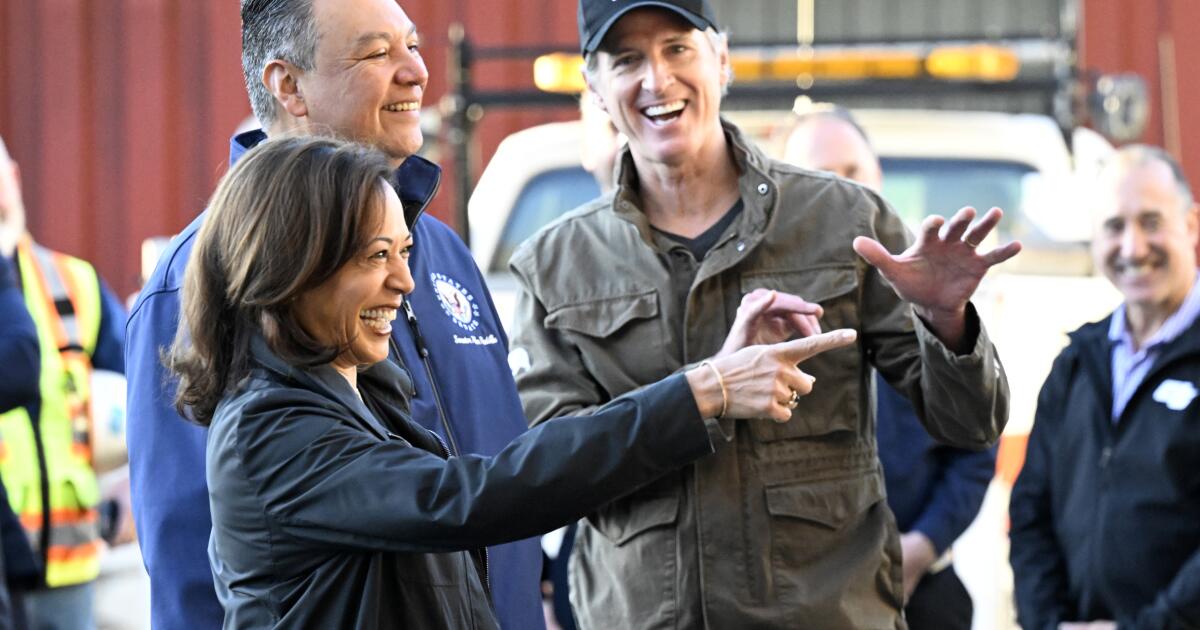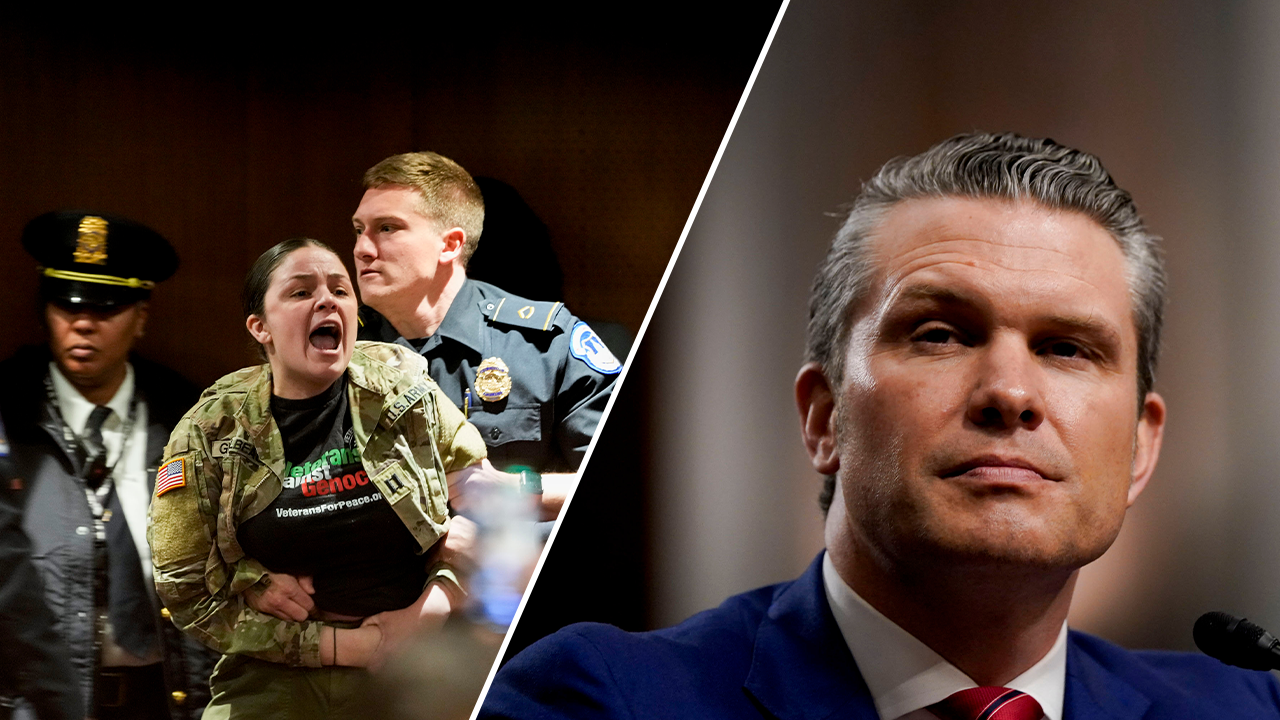Entertainment
Newsom heads to New York to raise money for Harris — then to Pennsylvania, where she'll debate Trump

Gov. Gavin Newsom is heading east to headline a splashy big-dollar fundraiser for Democratic presidential nominee Kamala Harris in New York before the vice president’s first debate with former President Trump on Tuesday in Philadelphia, which he’ll likely attend.
The governor will promote Harris and vice presidential nominee Tim Walz, the governor of Minnesota, from Sunday through Wednesday, according to a member of Newsom’s political team, making media appearances and attending fundraisers in New York and stumping for the Democratic ticket in the battleground state of Pennsylvania.
Newsom is jumping back into campaigning for the Democratic nominee after largely lying low in the weeks since Harris replaced President Biden at the top of the ticket. Newsom was a prominent surrogate for Biden, stumping for him around the country and defending him after his poor debate performance in June that ultimately led the incumbent to bow out of his reelection campaign.
But his role in Harris’ campaign had been unclear. Harris campaign officials said Saturday that Newsom is a leader of Harris’ national campaign committee, the same role he held with Biden’s campaign.
Harris and Newsom have a long history, having run in the same political circles in San Francisco before being sworn in together on the same day in 2004, Newsom as mayor and Harris as district attorney.
The vice president reminisced about their friendship at her first Bay Area fundraiser after becoming the presumptive Democratic presidential nominee in August.
“I have known Gavin as a friend and colleague for so, so many years,” she said. “I want to thank you in front of all of our friends who are here for being an extraordinary leader of California and the nation.”
Still, a vein of competition has marked their relationship for many years, as both were viewed as rising stars in the Democratic Party. It was particularly notable during the Democratic National Convention last month: Newsom attended, but without a prominent official role.
The governor, who normally seeks the spotlight, had only a brief moment on camera during the official programming when he announced California delegates’ votes for Harris. He said he turned down an opportunity to speak on the opening night of the convention because he was attending a school orientation for his children and couldn’t get to Chicago in time.
Newsom told The Times in an interview during the convention that he was awaiting an assignment from the Harris campaign and was mindful of how the rest of the nation views San Francisco and California.
“I’m deeply situationally aware of that, and that’s why I’m not asserting anything,” he said. “I’m happy. I don’t need anything or want anything. I just want to be helpful and not hurtful.”
One way Newsom is helping is by raising money. An invitation to Sunday’s fundraiser in New York City asks donors to contribute up to $100,000 to attend the event headlined by Newsom, former House Speaker Nancy Pelosi of San Francisco and House Minority Leader Hakeem Jeffries of New York. Hosts include producer Shonda Rhimes and actors Tony Goldwyn, Robert De Niro, Leslie Lloyd Odom Jr. and Amber Tamblyn.
The fundraiser is taking place as campaign disclosures show Harris with a gaping financial lead over Trump. The Democratic nominee’s campaign announced Friday that she and Walz and their allied committees had raised $361 million in August, the most in the current electoral cycle, and had $404 million in cash on hand.
Trump, running mate JD Vance and their allied committees raised $130 million in August and had $295 million in the bank, according to Republicans. The former GOP president is scheduled to return to California this week for a pair of high-dollar fundraisers, one notably hosted by relatives of Newsom’s wife, according to invitations obtained by The Times.
After New York, Newsom is scheduled to visit Pennsylvania. On Tuesday, Harris is debating Trump at the National Constitution Center in Philadelphia. His aides referred questions about his attendance at the debate to the Harris campaign, which did not respond to The Times’ question.
A source familiar with the plans, though not authorized to speak about them publicly, said that Newsom is widely “expected” to attend the faceoff as a surrogate who’s vocally promoting Harris in her historic run against Trump.

Entertainment
Kate Middleton's cancer is now in remission: 'It takes time to adjust to a new normal'

After battling cancer most of last year, Kate Middleton says she’s now in remission.
Catherine, Princess of Wales, who confirmed last March that she had cancer after months of speculation about her health and well-being, said Tuesday that she is focused on recovery.
“It is a relief to now be in remission and I remain [focused] on recovery,” she said in a statement posted on social media. “As anyone who has experienced a cancer diagnosis will know, it takes time to adjust to a new normal. I am however looking forward to a fulfilling year ahead. Thank you to everyone for your continued support.”
Catherine, Princess of Wales, and husband Prince William, who is first in line to the British throne, on Tuesday were named joint patrons of the Royal Marsden — the cancer hospital where Catherine received treatment last year. Since 2007, William has been president of the Royal Marsden, a position that was held previously by his mother, the late Princess Diana.
“I wanted to take the opportunity to say thank you to The Royal Marsden for looking after me so well during the past year,” Catherine said in her statement. “My heartfelt thanks goes to all those who have quietly walked alongside William and me as we have navigated everything. We couldn’t have asked for more. The care and advice we have received throughout my time as a patient has been exceptional.”
In her new role, the 43-year-old princess said she hopes to save more lives and transform the experience of all those affected by cancer by supporting groundbreaking research and clinical excellence, as well as promoting patient and family well-being.
Catherine’s health issues and the royal missteps that followed became a global topic of discussion early last year when Kensington Palace announced that she had to take a break from royal duties after having “major abdominal surgery” in January. Rampant speculation ran amok about the princess’ retreat from the public eye, fueling months of broad concern about her condition and whereabouts.
In March, she made the cancer announcement in a poignant video message that came in the wake of reports that her medical records at the London Clinic were allegedly breached by hospital staffers. She began treatment in late February and announced in September that she had completed it, confirming that she would soon return to light public duties.
The announcement of Catherine’s patronage was made Tuesday during her visit to the Royal Marsden’s hospital in Chelsea. There, the mother of three met with patients being treated with chemotherapy and immunotherapy.
“We were honoured to welcome Her Royal Highness The Princess of Wales to The Royal Marsden in Chelsea this morning, and are delighted that Her Royal Highness is now joining His Royal Highness The Prince of Wales in becoming Joint Patrons of our specialist cancer centre,” said Cally Palmer, chief executive of the Royal Marsden NHS Foundation Trust.
Palmer said William has been “a wonderful supporter of our work for nearly two decades” and that his and Catherine’s royal patronage is inspiring for staff and patients and “enables us to shine a light on the outstanding work our staff deliver every day for patients and their families.”
During her Tuesday visit, Catherine disclosed some of the side effects she experienced after her cancer treatment, including speech issues and brain fog.
“You think treatment’s finished, crack on with that … daily tasks, but that’s still like a real challenge,” she told hospital staff, according to the Daily Mail. “And talking … the words totally disappear … understanding that as a patient, yes, there are side effects around treatment, but actually there are more long-term side effects.”
Movie Reviews
Movie Review: Teen Temptress, Femme Fatale, or Victim? “Nahir”

“Nahir,” a brooding, glamourized and sexed-up account of a notorious Argentine murder case, is a mystery thriller that aims for engrossing and immersive that never falls short of quite watchable along the way.
Screenwriter Sofia Wilhelmi and director Hernán Gu
erschuny take great pains — with flashbacks and flashbacks within flashbacks — to show us several versions of the title character’s account of what happened the fateful night in which she allegedly killed her allegedly abusive lover.
We’re treated to backstory which dissects the aloof and mysterious teen beauty who either planned a crime of lover’s revenge, carried it out and took some pains to cover up her involvement, or didn’t. Not in the ways the earliest versions of her account of that fateful night played out, anyway.
Valentina Zenera plays Nahir as a vain beauty confident in her allure, even at her (seen in a flashback) quinceañera. Nahir dreams of riding the premiere float at Gualeguaychú’s famed carnival parade and riding that to fame as a model.
Not that she says much of this out loud. Nahir is depicted as inscrutable, controlled and controlling. All the boys fancy her and no one gets more of her attention, and manipulation, than 20 year-old Federico (Simon Hempe).
Nahir says they’re broken up. Then they’re together. As the narrative jumps back and forth from “before the crime” (in Spanish with English subtitles) to “after the crime,” we see both their torrid affair — “torrid” at least in his eyes — and her “No, we weren’t dating” way of describing it to her friends and eventually to the cops.
Because one night, Federico rides his motorbike to his doom.
We see how Nahir takes the “news” of his death. “Poker-faced” barely does that reaction justice. We watch the early questioning, the tear she tries to summon up or fake with a tissue.
And we learn that Nahir’s adored and adoring Dad (César Bordón) is a pistol-packing police officer. If there’s one thing that’s become accepted wisdom the world over in recent years, it’s the idea that police in most any country all consider themselves experts in one thing — knowing what they can get away with, and how.
When Dad says “I’ll get you out of here…I’m working on it. You’ll be home by New Year’s,” Nahir believes it. Is it because of what she knows, or what she knows that he knows?
As we see Nahir’s (perhaps) ex-beauty queen mother (Mónica Antonópulos) primp and prep her for a pageant and for a TV prison interview, we pick up on the dynamic of the household and the narcissism of our heroine.
“No crying,” Mom insists before her interrogation. Or did she? Federico’s come-ons are punctuated with a macho “I get anything I want.” Dad wasn’t shy about showing his pistol to would-be stalkers who stare at Nahir in crowds. His icy “princesa” never betrays any emotion at any of this.
The court case reveals more than just the lovers’ exchanged “love of my life” texts. Protesters demand “justice” for Federico, but witnesses paint a more complicated picture of their on-and-off romance. And as her situation isn’t quickly resolved — one way or the other — and her “story” changes, we wonder what really happened.
I like the way the story’s jumps backwards and forwards in time to wrongfoot the viewer. We’re given just enough information to decide on guilt or innocence, and then new information is brought to light. Think again.
Now on Amazon Prime, “Nahir” was longer when it played in Argentina, and reviews of this “true” story there weren’t the best. Perhaps it’s tighter, as the Prime cut of the film is 14 minutes shorter. Or perhaps Argentines are more invested in the story and uninterested in the doubts “Nahir” suggests.
Zenere, underplaying in ways that hint at the character’s similarities to Amanda Knox — accused because she underreacts to news of a murder — makes her character believably guilty or possibly innocent. And whatever verdict, she ensures the narcissistic Nahir is never seen with a hair out of place or eye shadow and earrings that aren’t perfectly matched, even behind bars.

Rating: TV-16, violence, sex, profanity
Cast: Valentina Zenere, Simon Hempe, Mónica Antonópulos and César Bordón
Credits: Directed by Hernán Guerschuny, scripted by Sofia Wilhelmi. An MGM release on Amazon Prime.
Running time: 1:48
Entertainment
Watch Duty, first responders and Steve Guttenberg: Jimmy Kimmel's ode to 'superheroes' of L.A. fires

Jimmy Kimmel is moved by community support and the commitment of first responders amid a dark period of L.A. history defined by devastating wildfires and immense loss.
Returning Monday to his late-night TV slot, Kimmel delivered an emotional opening monologue about the “very scary, very stressful, very strange week here in L.A.” Several fires broke out last week across Southern California, stoked by a “life-threatening and destructive” windstorm. The most devastating blazes, in Pacific Palisades and Altadena, continue to burn and have damaged or destroyed more than 12,000 structures and killed 24 people.
“It’s been terrible,” Kimmel said after reflecting on the fires, including the since-extinguished Sunset fire that threatened his studio in Hollywood. “Everyone who lives in this city knows someone, most of us multiple people — families, friends, colleagues, neighbors — whose houses burned down, and the truth is we don’t even know it’s over.”
The last week has been a “sickening, shocking, awful experience,” but Kimmel also said a bright spot has been the “beauty from seeing the community coming together to support each other.” After briefly chiding President-elect Donald Trump for railing against California politicians, Kimmel turned the spotlight onto first responders, including the inmate crews that have been battling the wildfires.
“We should never stop thanking them,” Kimmel said. In addition to local and out-of-state first responders, the Emmy-winning host also lauded police, the National Guard, local news reporters and the Watch Duty app.
“Real superheroes,” he added.
Kimmel’s opening segment also praised the Angelenos who have organized donation drives, businesses that have offered support to affected residents and “unexpected hero” Steve Guttenberg. Since last week, the “Police Academy” star has remained in his Palisades neighborhood to aid emergency efforts. Guttenberg told Kimmel his latest mission has included saving a dog and putting out small fires in the area.
Although the fires have brought devastation, Kimmel said, the last week has also been full of various lessons — including those on firefighting terminology and emergency responses.
“I feel like I’m an expert now,” he joked. “Before this happened, most of what I knew about fire safety came from watching ‘Paw Patrol.’”
The final minutes of Kimmel’s 15-minute monologue featured a super-cut of local coverage highlighting community efforts, including donation drives and free meal services.
On Monday, the “Jimmy Kimmel Live!” team announced its efforts to give back to people affected by the fires. The production has set up a donation center behind its Hollywood studio, at 6901 Hawthorn Ave. The center will be open from 10 a.m. to 6 p.m. daily until Friday.
SoCal residents should remain vigilant this week as officials voiced concern that a new round of strong winds, paired with dry fuel and low humidity, could result in new fires starting or existing blazes expanding. An unprecedented fourth “particularly dangerous situation” fire weather warning took effect Tuesday morning and is expected to last through Wednesday, affecting swaths of Los Angeles County and surrounding counties.
“Life-threatening and destructive and widespread winds are already here,” Los Angeles Fire Chief Kristin Crowley said during a news conference Tuesday. “We are taking an aggressive, lean forward posture … strategically placing fire patrols and engines in the unimpacted high fire risk areas in the city. We are carefully managing our operations to ensure that we can quickly respond to any new fires.”
Times staff writers Rong-Gon Lin II, Hannah Fry and Grace Toohey contributed to this report.
-

 Health1 week ago
Health1 week agoOzempic ‘microdosing’ is the new weight-loss trend: Should you try it?
-
/cdn.vox-cdn.com/uploads/chorus_asset/file/25822586/STK169_ZUCKERBERG_MAGA_STKS491_CVIRGINIA_A.jpg)
/cdn.vox-cdn.com/uploads/chorus_asset/file/25822586/STK169_ZUCKERBERG_MAGA_STKS491_CVIRGINIA_A.jpg) Technology6 days ago
Technology6 days agoMeta is highlighting a splintering global approach to online speech
-

 Science3 days ago
Science3 days agoMetro will offer free rides in L.A. through Sunday due to fires
-
/cdn.vox-cdn.com/uploads/chorus_asset/file/25821992/videoframe_720397.png)
/cdn.vox-cdn.com/uploads/chorus_asset/file/25821992/videoframe_720397.png) Technology7 days ago
Technology7 days agoLas Vegas police release ChatGPT logs from the suspect in the Cybertruck explosion
-

 Movie Reviews1 week ago
Movie Reviews1 week ago‘How to Make Millions Before Grandma Dies’ Review: Thai Oscar Entry Is a Disarmingly Sentimental Tear-Jerker
-

 Health1 week ago
Health1 week agoMichael J. Fox honored with Presidential Medal of Freedom for Parkinson’s research efforts
-

 Movie Reviews1 week ago
Movie Reviews1 week agoMovie Review: Millennials try to buy-in or opt-out of the “American Meltdown”
-

 News7 days ago
News7 days agoPhotos: Pacific Palisades Wildfire Engulfs Homes in an L.A. Neighborhood















